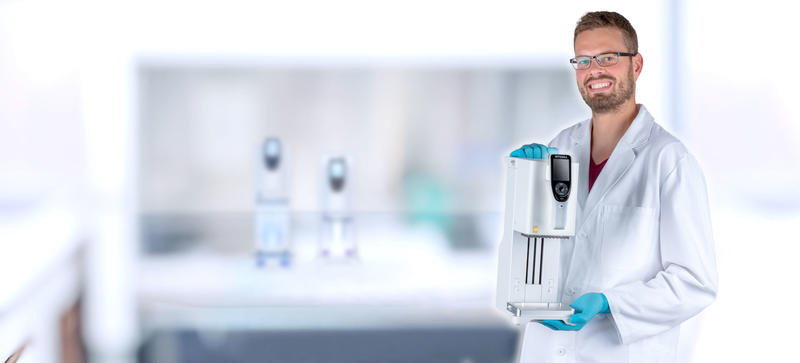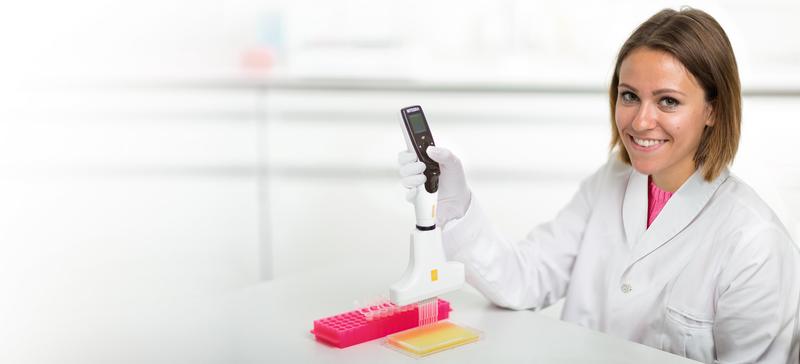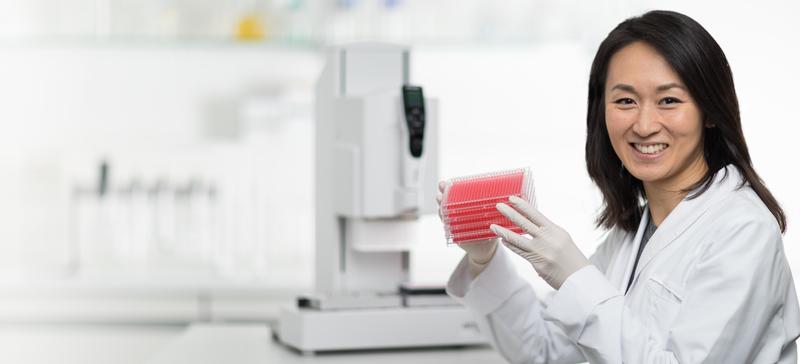-
Automated DNA clean-up using the Zymo Research DNA Clean & Concentrator™ MagBead Kit
Get your ultrapure DNA with the ASSIST PLUS pipetting robot
DNA clean-up methods are used to purify samples of DNA by removing any unwanted components. This is crucial for the success of downstream processes in genomics, biotechnology, molecular biology, clinical research and other fields of biology.
Zymo Research’s DNA Clean & Concentrator™ (DCC) MagBead kit offers a magnetic bead-based DNA clean-up for PCR and next generation sequencing (NGS). Its single buffer system can recover DNA from enzymatic reactions, impure extractions, library preparations, and other sources. The kit can be used with the VOYAGER adjustable tip spacing pipette on the ASSIST PLUS pipetting robot to automate DNA purification and concentration, enabling high throughput processing.
The results of the DNA clean-up automated protocols show high reproducibility, along with top-notch yield and purity values.
-
Table of contents
DNA clean-up methods are used to purify samples of DNA by removing any unwanted components. This is crucial for the success of downstream processes in genomics, biotechnology, molecular biology, clinical research and other fields of biology.
Zymo Research’s DNA Clean & Concentrator™ (DCC) MagBead kit offers a magnetic bead-based DNA clean-up for PCR and next generation sequencing (NGS). Its single buffer system can recover DNA from enzymatic reactions, impure extractions, library preparations, and other sources. The kit can be used with the VOYAGER adjustable tip spacing pipette on the ASSIST PLUS pipetting robot to automate DNA purification and concentration, enabling high throughput processing.
The results of the DNA clean-up automated protocols show high reproducibility, along with top-notch yield and purity values.
Key benefits
- Automated DNA clean-up with Zymo's DCC on the ASSIST PLUS pipetting robot makes DNA clean-up a cakewalk. Manual intervention is needed only when moving labware on and off the magnetic separator and shaker.
- The VIALAB software provides easy programming and includes a labware change feature for overcoming the hurdle of limited deck space.
- The optimized liquid handling parameters on ASSIST PLUS allow efficient DNA clean-up, without bead or buffer carryover. Using the pipetting robot guarantees that pipetting is always performed from and to the same position, ensuring consistent results every time. Accurate pipetting height, pre- and post-dispense, and ideal pipetting speed have been refined for careful handling of liquids and magnetic beads, helping to achieve the desired results.
- The DNA clean-up protocol can be simplified thanks to our innovative labware accessories. Reservoirs with SureFlo™ anti-sealing array allows the lowest possible dead volume for valuable liquids. The dual reservoir adapter accommodates 2 divided reagent reservoirs with compartments for 4 different reagents. The 96 well cooling block keeps precious reagents cold and serves as a storage place for the PCR plate on the deck.
- GRIPTIPS® pipette tips are designed to create a perfect seal with the VOYAGER pipette, ensuring that they never leak or fall off. Using low retention GRIPTIPS guarantees precise pipetting of volatile solutions, such as ethanol.
- Using the VOYAGER automated tip spacing electronic pipette gives unlimited flexibility and easy transfers between different labware formats.
Overview: How to get ultra pure DNA with Zymo's DCC kit
Step-by-step procedure
The ASSIST PLUS pipetting robot is used together with the 8 channel 300 µl VOYAGER automated tip spacing electronic pipette and 300 µl sterile, filter, low retention GRIPTIPS in this semi-automated workflow to purify nucleic acid (Figure 1).
Downloads: App note and protocols for automated DNA clean-up using Zymo Research DNA Clean & Concentrator MagBead Kit
The total DNA clean-up workflow is composed of 3 main steps:
- Binding
- Washing
- Elution
Experimental set-up
Deck position A: dual reservoir adapter with 2 divided reservoirs
Deck position B: Sapphire 96 well PCR plate (Greiner Bio-one) on a PCR cooling block
Deck position C: Thermo Scientific™ Abgene™ 96 well 0.8 ml polypropylene DeepWell™ plate
Binding
Preparation of samples, buffer and magnetic bead addition.
Place the dual reservoir adapter at deck position A. Place 2 divided reservoirs onto the deck, fill 1 of the 10 ml compartments with 2.2 ml of DNA MagBinding Buffer (Figure 2, pink) and the other with 9 ml of DNA Wash Buffer (Figure 2, lilac). Next, place a 96 well PCR plate with nuclease-free water, MagBinding Beads and DNA Elution Buffer (Figure 2, blue, green and yellow, respectively) at position B (Figure 3).

Lastly, place the DeepWell plate containing the 30 µl samples (Figure 2, dark blue) at deck position C.
Select and run the VIALAB program 'Zymo DCC'. The VOYAGER automated tip spacing electronic pipette will transfer 20 µl of nuclease-free water (with a 5 µl pre- and post-dispense) into the samples, so that the starting volume of the nucleic acid to be purified is 50 µl, as suggested by the DCC kit manufacturer. Next, the correct volume of DNA MagBinding Buffer – corresponding to 4 times the volume of input DNA so, in this case, 4x50 μl=200 μl – is added to each sample, followed by 10 cycles of accurate mixing at speed 5. The MagBinding Beads are mixed thoroughly over 10 cycles to ensure they are kept in suspension, and 20 µl of beads are added to the samples (Figure 4). The magnetic beads are then mixed with the nucleic acid to be purified over 15 cycles.
In the next step, the pipetting robot instructs the user to put the DeepWell plate onto the shaker for 10 minutes at 1300 rpm. This step improves the binding of the nucleic acid to the magnetic beads.
After shaking, a message on the pipette will tell the user to put an empty reservoir at deck position A (A2) for waste and to place the DeepWell plate with the sample and magnetic beads onto the magnetic separation device at deck position C (Figure 5).
After pressing ‘OK’, a 2-minute incubation will follow to allow magnetic bead capture. The pipetting robot will then automatically move on to the next step, where it will remove the supernatant from the plate on the magnetic separation device.
Tips:
- Pre- and post-dispense steps can be used in liquid transfers throughout this protocol to guarantee precise pipetting.
- Use slow aspiration speeds of 1 or 2 during supernatant removal to avoid magnetic bead loss.
Washing
Purification with DNA Wash Buffer.
The pipette directs the user to remove the magnetic separation device and place the DeepWell plate back at position C. In the first purification step, 500 µl of DNA Wash Buffer is added in 2 transfer steps and mixed with the magnetic beads (Figure 6). Then a message on the pipette tells the operator to place the DeepWell plate back onto the magnetic separation device at position C and incubate it for 2 minutes. After incubation, the pipetting robot goes directly to the next step and removes the supernatant. The first washing step is repeated, and then the leftover wash buffer is carefully removed. The pipette informs the user that a 10 - minute incubation time is now required to dry the magnetic beads; this incubation step is needed to ensure that residual buffer does not inhibit downstream applications.
Tip:
- The wash buffer contains ethanol. Make sure you use the correct pipetting speed, air gap, and low retention tips for precise pipetting without dripping.
Elution
Eluting the samples in DNA Elution Buffer.
After the drying step, the operator should remove the magnetic separation device from below the DeepWell plate. ASSIST PLUS will add 50 µl of DNA Elution Buffer and then perform 10 mixing cycles (Figure 7). A message will pop up, telling the user that the DeepWell plate should be placed onto the shaker for 5 minutes. This guarantees that all the DNA is eluted from the magnetic beads into the buffer. After shaking, the DeepWell plate should be placed onto the magnetic separation device at position C, where the magnetic beads will be captured during a 2-minute incubation. The pipetting robot will then inform the user that a new 96 well plate for the eluted DNA should be placed at deck position B in landscape orientation. In the last step, the pipette transfers 45 µl of eluted DNA to the new 96 well plate.
Tip:
- The eluted DNA can be used immediately or stored at -20 °C until further use.
Results
The automated DCC MagBead protocol on ASSIST PLUS shows high DNA recovery from PCR, that is ready to use in any downstream application. The automated workflow resulted in greater DNA yield, better purity (A260/A280 and A260/A230 ratios) and higher reproducibility (lower SD values).
Remarks
- VIALAB software: VIALAB programs can be easily adapted to the user’s specific labware and protocols.
- Run report: If the ASSIST PLUS pipetting robot is connected to the PC with VIALAB, programs can be started directly from the PC. A report is automatically generated after a run, documenting details such as the start/end time, user, calculated volumes and any errors that occurred. This offers a convenient way to fulfill regulatory requirements.
Conclusion
- The ASSIST PLUS pipetting robot in combination with the VOYAGER electronic pipette offers a seamless and efficient DNA clean-up solution using the Zymo Research DNA Clean & Concentrator MagBead Kit for low to high throughput sample batches.
- Automated pipetting steps avoid the introduction of human error, generating highly reproducible and reliable results.
- Wash buffers normally contain ethanol, but no dripping occurs in the washing steps in this protocol, thanks to INTEGRA's special low retention GRIPTIPS.
- The whole semi-automated DNA clean-up workflow can be programmed as a single VIALAB program using the labware change function.
- The optimized liquid handling parameters on ASSIST PLUS enable precision pipetting, resulting in high DNA yields and purity.
- The results of the semi-automated protocol were comparable to the manual protocol in terms of DNA yield and purity. The ASSIST PLUS protocol helped to reduce standard deviations, indicating improved consistency and reproducibility of the DNA clean-up process over manual clean-up.
Ask our expert. Leave a comment!
Write us if you have any questions regarding the application note or one of our instruments.
Any questions? I'm happy to help!
Instruments and accessories
ASSIST PLUS, Pipetting Robot
INTEGRA has developed the ASSIST PLUS pipetting robot to streamline routine pipetting tasks at an affordable price. Using INTEGRA electronic multichannel pipettes, the system:
- automates pipetting tasks,
- eliminates physical strain and
- ensures superior reproducibility and
- error free pipetting.
Part No. 4505
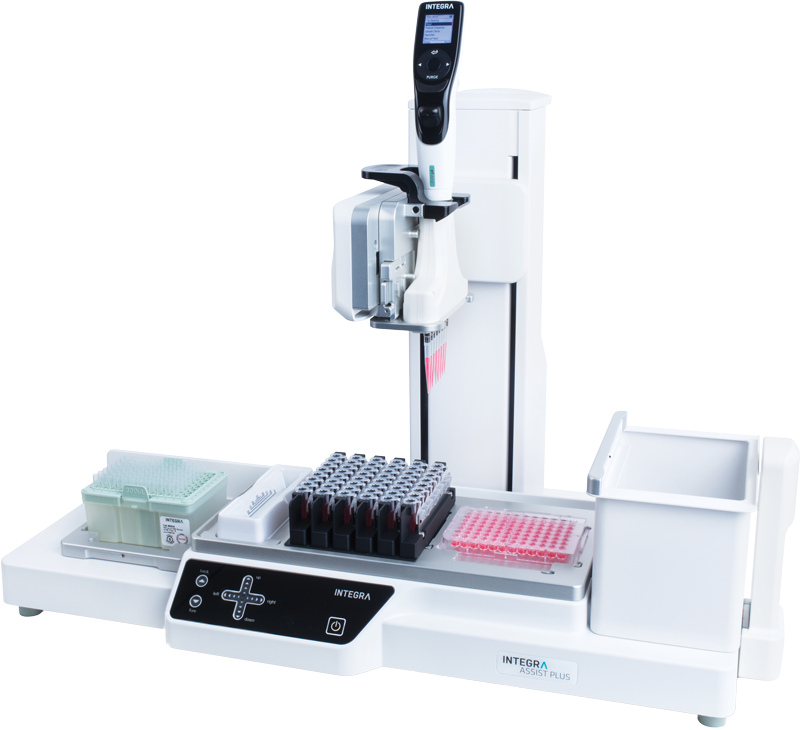
VOYAGER, 8 Channel, 300 µl
VOYAGER pipettes allow the tip spacing to expand anywhere between 4.5 mm and 33 mm at the push of a button.
- Single handed operation leaves the other hand free to handle labware.
- On the fly access to up to 3 user-defined tip spacings.
- These user defined tip spacings are saved. No need to memorize spacings of different labware formats.
Part No. 4723
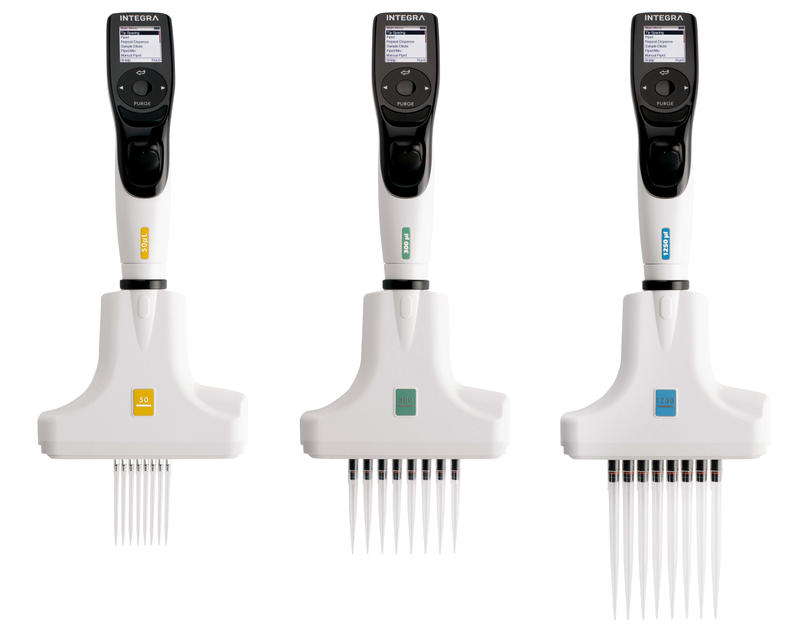
Communication module for INTEGRA electronic pipettes
For pairing INTEGRA electronic pipettes with the ASSIST PLUS.
Part-Nr. 4221
GRIPTIPS®, 300 µl, Sterile, Filter
GRIPTIPS® pipette tips perfectly match the multi-lobe tip fitting, snapping firmly on during loading. This guarantees a perfect seal on every tip, preventing them from loosening, leaking or completely falling off. All tips are precisely aligned horizontally, enabling accurate touch-offs, even when pipetting with 384 tips.
Part No. 3435
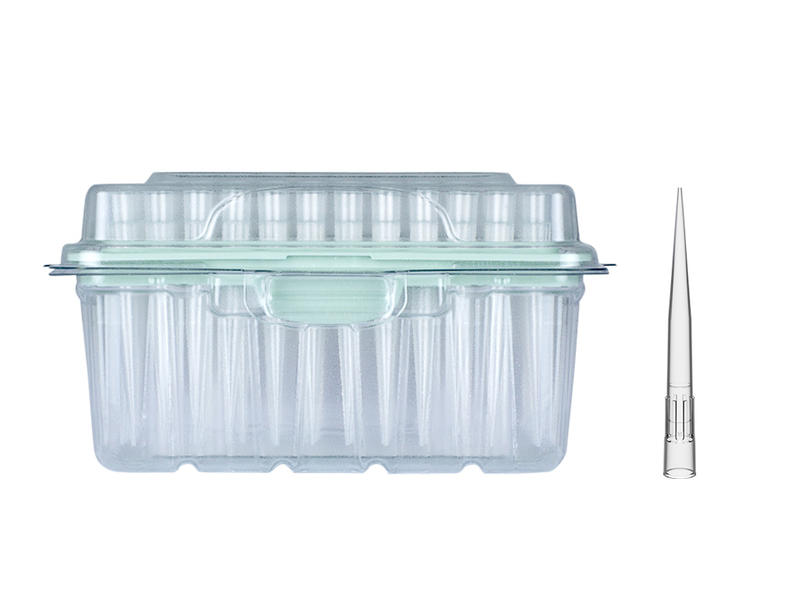
Dual Reservoir Adapter
The dual reservoir adapter makes this system ideal for assays that required sequential addition of several low volume reagent mixes. This adapter holds two 10 ml, 25 ml or divided reagent reservoirs side by side in an aluminum frame, and can be pre-chilled to keep reagents cool during processing.
Part No. 4547
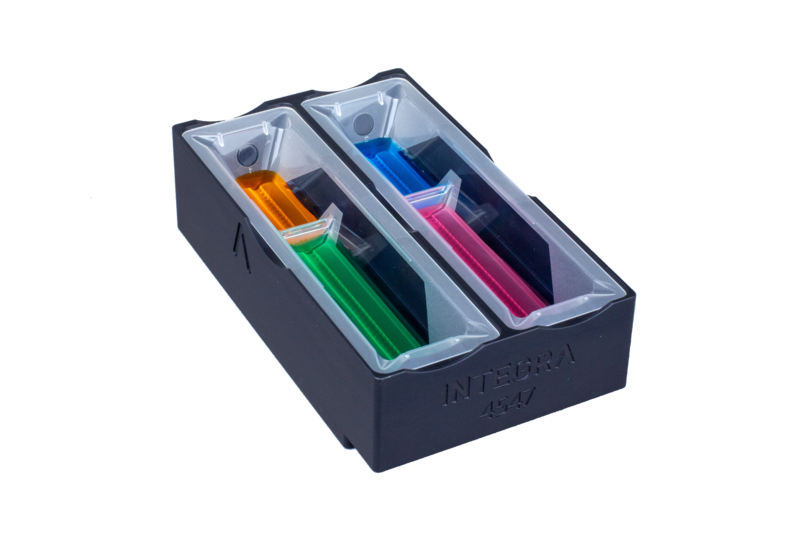
Divided Reagent Reservoir, Sterile, SureFlo anti-sealing array, 25 ml, PP
Lowest Dead Volume On The Market!
25 ml divided reservoirs are comprised of 5 and 10 ml compartments, while still nesting comfortably in the standard 25 ml reusable, sturdy base.
Each reservoir features the SureFlo™ anti-sealing array and hydrophilic surface treatment providing especially low dead volumes.
Part No. 4356 / 4357
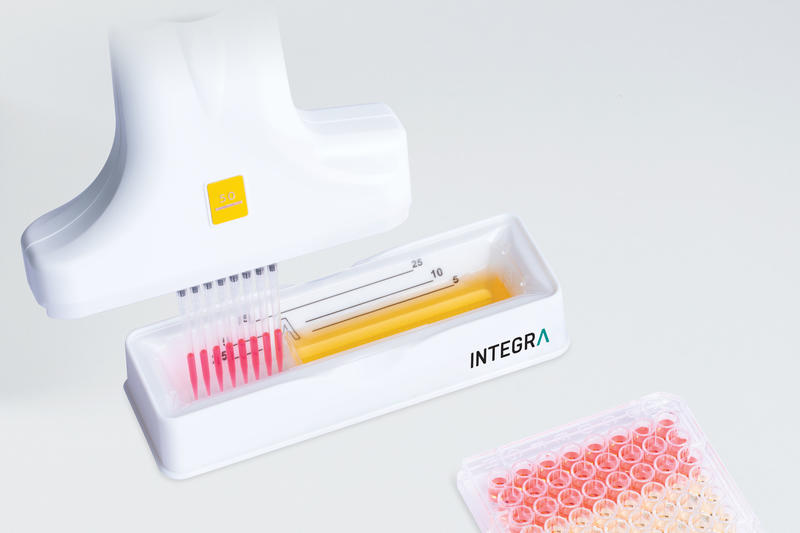
PCR 96 well cooling block
Aluminium 96 and 384 well PCR cooling blocks that keep reagents chilled during sample preparation in a PCR plate. The cooling blocks feature a SBS footprint.
Part No. 6250
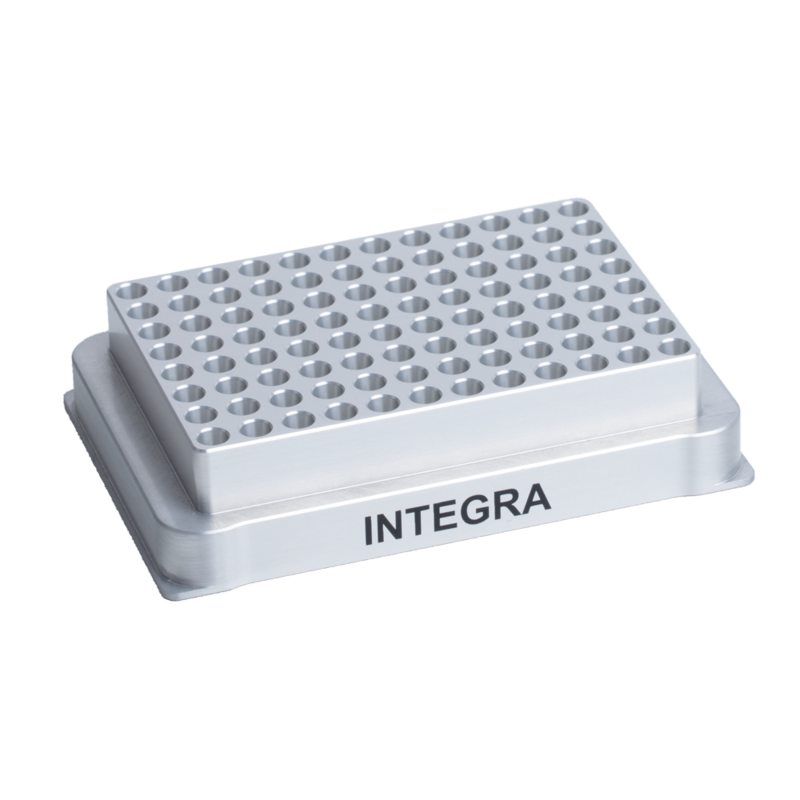
Zymo Research: DNA Clean & Concentrator™ MagBead Kit
The DNA Clean & Concentrator MagBead Kit is magnetic bead based clean-up kit that can purify DNA from PCR, enzymatic reactions, impure extractions, and other sources. The MagBinding Bead technology provides a rapid and scalable workflow that can be adapted for low to high-throughput automated method for purification and concentration of DNA.
Source: Website supplier
Promega: Deep Well MagnaBot® 96 Magnetic Separation Device
The Deep Well MagnaBot® 96 Magnetic Separation Device is designed for high-throughput bioseparation using magnetic particles such as MagneSil® Paramagnetic Particles for magnetic separation in deep-well plates as an alternative to vacuum filtration and centrifugation separation formats. This MagneSil® technology allows the use of paramagnetic particles for automated nucleic acid purification applications such as plasmid purification, PCR clean-up and dye terminator clean-up prior to automated sequencing.
Part Nr.: V3031
Source: Website Promega
Thermo Fisher Scientific: Abgene™ 96 Well 0.8 ml Polypropylene DeepWell™ Sample Processing & Storage Plate for Genomics and NGS library preparation
Thermo Scientific™ Abgene™ polypropylene microplates and DeepWell plates offer storage security for assays, compound libraries or storing samples for either intermediate or long term use and have molded slots and pads for automated sample processing and preparation workflows. Abgene microtiter plates are manufactured to exacting specifications in our Class 100,000 clean room ISO 9001 conditions using USP <661.1> high quality medical grade virgin polypropylene resins, which ensure confidence in the quality and performance of the storage plates. Designed to ANSI standards these microplates and DeepWell plates are compatible with a variety of automated liquid handling for high throughput workflows. The polypropylene storage plates are offered with spindle, pyramidal, U and V bottom wells along with a wide range of volumes to accommodate most applications.
Part No. AB0859
Source: Supplier Website
Greiner Bio-One: Sapphire microplate, 96 well, PP
- Free of detectable DNase, RNase, human DNA
- Non-Pyrogenic
- Ultra thin polypropylene for optimal heat transfer from the thermoblock to the reaction solution
- Are particularly suited for automation
- They are both "robot-freindly" for grippers, and have sufficient space for the application of barcodes
- Sealable with sealers "SILVERseal™", "VIEWseal™" and "AMPLIseal™"
- Volume per well: 0.2 ml
- Full-skirted
Source: Website supplier
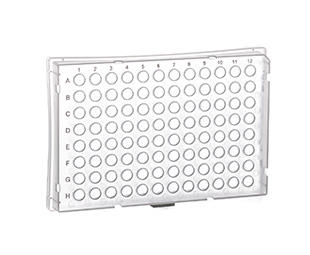
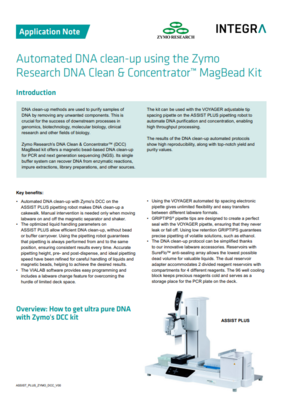
Downloads
Download App Note as PDF
DownloadAutomated DNA clean-up using the Zymo Research DNA Clean & Concentrator™ MagBead KitCustomer’s voice
We have many operations that are performed in column or plate format and the ASSIST PLUS and MINI 96s have drastically reduced the time needed for many of the pipetting steps. As important, they also reduce the risk of error when pipetting many samples.

